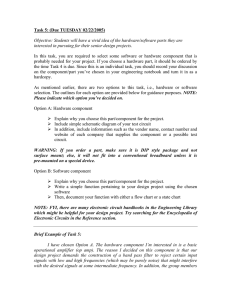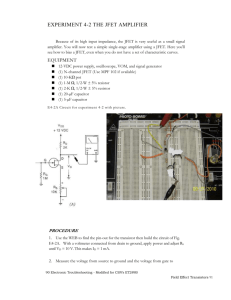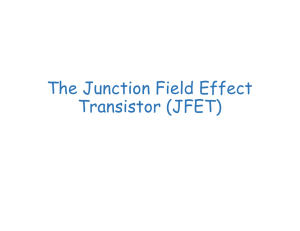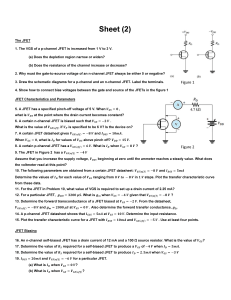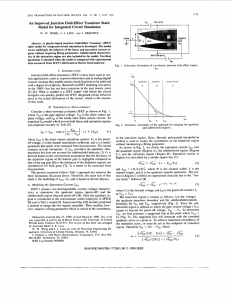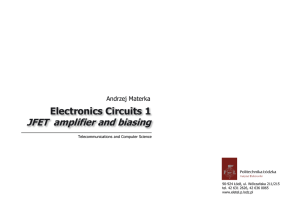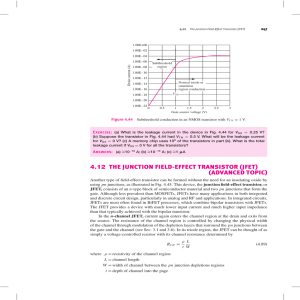FET Amplifier & Inverter Lab Guide - Electronics I
advertisement
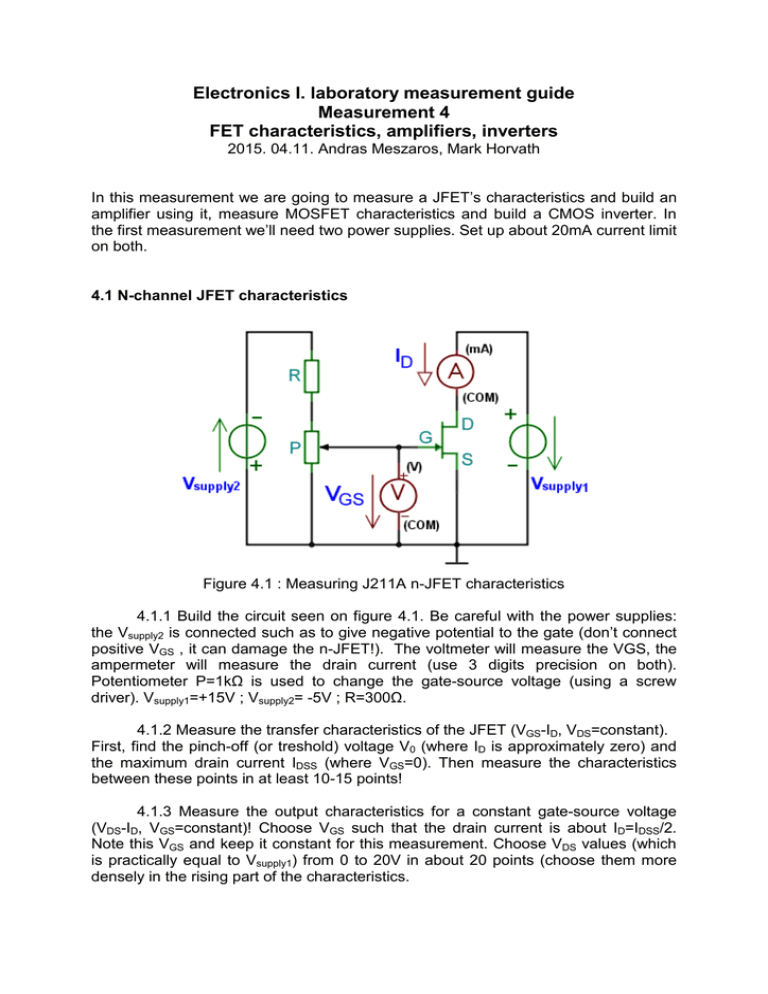
Electronics I. laboratory measurement guide Measurement 4 FET characteristics, amplifiers, inverters 2015. 04.11. Andras Meszaros, Mark Horvath In this measurement we are going to measure a JFET’s characteristics and build an amplifier using it, measure MOSFET characteristics and build a CMOS inverter. In the first measurement we’ll need two power supplies. Set up about 20mA current limit on both. 4.1 N-channel JFET characteristics Figure 4.1 : Measuring J211A n-JFET characteristics 4.1.1 Build the circuit seen on figure 4.1. Be careful with the power supplies: the Vsupply2 is connected such as to give negative potential to the gate (don’t connect positive VGS , it can damage the n-JFET!). The voltmeter will measure the VGS, the ampermeter will measure the drain current (use 3 digits precision on both). Potentiometer P=1kΩ is used to change the gate-source voltage (using a screw driver). Vsupply1=+15V ; Vsupply2= -5V ; R=300Ω. 4.1.2 Measure the transfer characteristics of the JFET (VGS-ID, VDS=constant). First, find the pinch-off (or treshold) voltage V0 (where ID is approximately zero) and the maximum drain current IDSS (where VGS=0). Then measure the characteristics between these points in at least 10-15 points! 4.1.3 Measure the output characteristics for a constant gate-source voltage (VDS-ID, VGS=constant)! Choose VGS such that the drain current is about ID=IDSS/2. Note this VGS and keep it constant for this measurement. Choose VDS values (which is practically equal to Vsupply1) from 0 to 20V in about 20 points (choose them more densely in the rising part of the characteristics. 4.2 Common-source JFET amplifier 4.2.1 Build the amplifier circuit seen on figure 4.2. Data: RL=RD=5.1kΩ ; RG=1MΩ ; RS=2,2kΩ (potentiometer). C1=C2=100nF ; CS=47µF, Vsupply=15V. Do not connect neither the function generator nor oscilloscope on the inputs and outputs yet. Figure 4.2: CS JFET amplifier 4.2.2 Measurement of the operating point parameters. Setup the potmeter RS such that VD is equal to half of the power supply voltage (VD=Vsupply/2). (The potmeter is needed because the JFET’s parameters have a large manufacturing tolerance, thus we can’t design the circuit with precise resistor values). After setting up the potmeter, take it out of the circuit, measure and note its resistance, then put it back into the circuit. Measure VS. Calculate the drain current ID and the expected gain AV. How much is VG and why? 4.2.3 Connect the point Vin to the analog output of the function generator and also to channel 1 of the oscilloscope (use a BNC-BNC T-junction and BNC-BNC cables). Connect Vout to channel 2 of oscilloscope. Check the correct trigger setup (Edge). Setup an f=5kHz, 500mV peak-to-peak sine wave output on the function generator. Draw and measure the input and output signals, including p-p values, phases, frequency/period. Measure the voltage gain (convert to dB as well) and compare with the calculated value. 4.2.4 Remove capacitor CS and measure the gain. 4.2.5 Measure the lower and higher limit frequencies! Put back the CS capacitor into the circuit. Change the function generator’s frequency (in both directions) until the output signal’s p-p value is about 70% of the original (this is the -3dB point). These will be the limit frequencies. To help measure the peak-to-peak voltages, setup the oscilloscope to XY mode and remove Vin from the scope (not from the circuit!). Now you should see a single (vertical or horizontal) line, the length of which is equal to the p-p value of Vout. 4.3 Transfer characteristics of n-channel enhancement MOSFET Figure 4.3: measuring nMOS characteristics 4.3.1 Build the circuit of figure 4.3 to measure BS170 n-channel enhancement MOSFET’s transfer characteristics (VGS-ID, VDS=constant). Setup 3 digits of precision on the ampermeter and the voltmeter. RD=180Ω (PRDmax=5W). Setup a current limit of 100mA on Vsupply (which will be first 5V, then 10V). 4.3.2 Setup Vsupply=5V. Measure the transfer characteristics by changing VGS between 0..5V every half volts! When VGS=5V, measure VDS, and calculate RDSON. Compare it with datasheet value! 4.3.3 Repeat the previous measurement with Vsupply=10V. 4.4 CMOS inverter Figure 4.4: CMOS inverter 4.4.1 Build a complementary MOS inverter as seen on figure 4.4. The n-MOS is the BS-170 from the previous measurement, the p-MOS is BS250. RS=13Ω. Vsupply=5V. Connect the TTL output of the function generator to Vin, also to oscilloscope channel 1 (using the T-junction again). Connect Vout1 to channel 2. 4.4.2 Setup 100kHz frequency on the function generator. Amplitude and other parameters are irrelevant, as we are using the TTL output (second BNC from right), which outputs a standard 50% duty cycle, 0..+5V square wave. Measure and draw the input and output signals with proper phases; show that it is an inverter. 4.4.3 Connect channel 2 to Vout2, thus measuring the voltage on RS. The signal is expected to be in the mV range! Draw the signals Vin and Vout2 with proper phases and explain what you see! 4.5 Test questions 1. Draw the transfer and output characteristics of a n-JFET in common source mode. Note the parameter for the output curves. Note the special points. 2. Draw the transfer and output characteristics of an enhancement mode n-MOSFET! 3. Draw a common source n-JFET amplifier circuit. Name the components. 4. Write down the equation of the transfer characteristics of the JFET and explain the parameters. 5. What is the RDSon parameter of MOSFETs? What is its use / importance? 6. Draw the circuit symbols of n- and p-channel JFETs, enhancement and depletion mode MOSFETs! Name the pins! 7. Define the concept of slope (transfer conductance) and give the equation of it for the JFET! 8. Define the concept of lower and upper limit frequencies (in words and with graphs). 9. What do you know about the gate current of MOSFETs in low frequency and high frequency? 10. How much is the input resistance of a CS JFET amplifier? 11. What is the output resistance of a CS JFET amplifier? 12. What does CMOS mean and how does a CMOS inverter work? 13. What causes the non-zero current consumption of a CMOS inverter even when the load is open-circuit? 14. Give the temperature dependence of a JFET’s transfer characteristics using graphs. 15. Why is a JFET amplifier’s voltage gain much smaller than that of a bipolar transistor amplifier?
